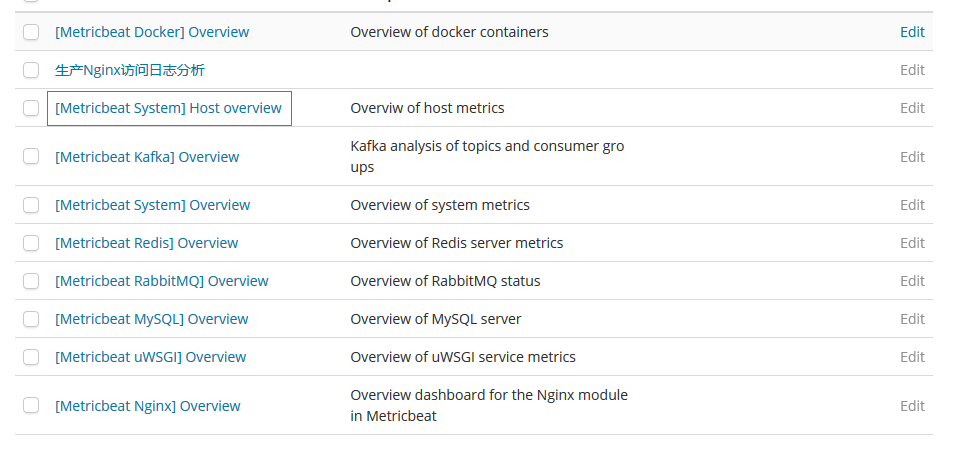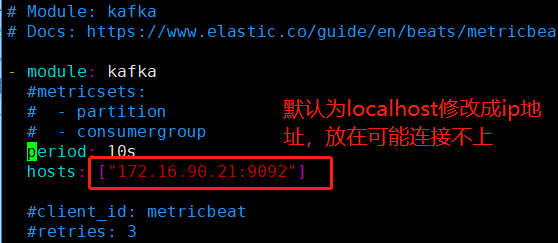ELK之使用metricbeat收集系统数据及其他程序并生成可视化图表
将 Metricbeat 部署到您所有的 Linux、Windows 和 Mac 主机,并将它连接到 Elasticsearch 就大功告成啦:您可以获取系统级的 CPU 使用率、内存、文件系统、磁盘 IO 和网络 IO 统计数据,以及获得如同系统上 top 命令类似的各个进程的统计数据
1,安装metricbeat
官网下载rpm包安装
1 | rpm -ivh /nas/nas/softs/elk/6.5.4/metricbeat-6.5.4-x86_64.rpm |
默认开启了system模块使用命令查看模块
1 2 3 4 5 6 7 8 9 10 11 12 13 14 15 16 17 18 19 20 21 22 23 24 25 26 27 28 29 30 31 32 33 34 35 36 37 38 39 40 | metricbeat modules listEnabled:systemDisabled:aerospikeapachecephcouchbasedockerdropwizardelasticsearchenvoyproxyetcdgolanggraphitehaproxyhttpjolokiakafkakibanakuberneteskvmlogstashmemcachedmongodbmuninmysqlnginxphp_fpmpostgresqlprometheusrabbitmqredistraefikuwsgivspherewindowszookeeper |
PS:Enabled模块为启用模块 Disabled模块为未启用模块
启用新模块命令,例如启用nginx模块
1 | metricbeat modules enable nginx |
修改配置文件监控系统CPU,内存等信息
1 2 3 4 5 6 7 8 9 10 11 12 13 14 15 16 17 18 | #包含其他模块的配置文件metricbeat.config.modules: path: ${path.config}/modules.d/*.yml reload.enabled: falsesetup.template.settings: index.number_of_shards: 1 index.codec: best_compression#开启dashboardssetup.dashboards.enabled: true#输出至kibanasetup.kibana: host: "172.16.90.24:5601"#输出至elssticsearchoutput.elasticsearch: hosts: ["172.16.90.24:9200"]processors: - add_host_metadata: ~ - add_cloud_metadata: ~ |
启动metricbeat
1 | systemctl start metricbeat |
打开kibana页面查看自动生成了一些图表

查看hostview



如果多个主机需要监控系统性能查看


2,设置监控nginx性能
开启nginx模块
1 | metricbeat modules enable nginx |
修改metricbeat配置文件/etc/metricbeat/modules.d/nginx.yml
1 2 3 4 5 6 | - module: nginx metricsets: ["stubstatus"] hosts: ["http://172.16.100.132"] #username: "user" #password: "secret" server_status_path: "status" |
PS:监控nginx前提需要开启nginx状态模块并在nginx配置下添加以下配置
1 2 3 4 5 6 7 8 9 | server{ listen 80; server_name 172.16.100.132; location /status { stub_status; access_log off; }} |
配置成功在web页面可以查看到以下信息

重启metricbeat查看


3,设置监控MySQL
开启MySQL模块
1 | metricbeat modules enable mysql |
修改配置文件
1 | /etc/metricbeat/modules.d/mysql.yml |
1 2 3 4 5 6 7 8 9 10 11 12 13 14 15 16 | - module: mysql metricsets: - status # - galera_status period: 10s # Host DSN should be defined as "user:pass@tcp(127.0.0.1:3306)/" # The username and password can either be set in the DSN or using the username # and password config options. Those specified in the DSN take precedence. hosts: ["tcp(172.16.90.180:3306)/"] # Username of hosts. Empty by default. username: root # Password of hosts. Empty by default. password: secret |
kibana页面查看

4,设置监控redis
开启redis模块
1 | metricbeat modules enable redis |
修改配置文件
1 | /etc/metricbeat/modules.d/redis.yml |
1 2 3 4 5 6 | - module: redis hosts: ["172.16.90.181:6379"] metricsets: ["info","keyspace"] enables: true period: 10s password: password |
PS:如果redis没有设置认证则密码不配置
kibana查看

5,设置监控rabbitmq
开启rabbitmq模块
1 | metricbeat modules enable rabbitmq |
修改配置文件
1 | /etc/metricbeat/modules.d/rabbitmq.yml |
1 2 3 4 5 6 7 | - module: rabbitmq metricsets: ["node", "queue", "connection"] enabled: true period: 10s hosts: ["172.16.90.46:15672"] username: admin password: password |
kibana页面查看

6,设置监控kafka
开启kafka监控模块
1 | metricbeat modules enable kafka |
修改配置文件
1 | /etc/metricbeat/modules.d/kafka.yml |

kibana页面查看

7,设置监控docker
开启docker监控模块
1 | metricbeat modules enable docker |
设置生效
1 | metricbeat setup |

登录kibana查看




其他程序监控可参考官方文档 https://www.elastic.co/guide/en/beats/metricbeat/current/metricbeat-modules.html





【推荐】国内首个AI IDE,深度理解中文开发场景,立即下载体验Trae
【推荐】编程新体验,更懂你的AI,立即体验豆包MarsCode编程助手
【推荐】抖音旗下AI助手豆包,你的智能百科全书,全免费不限次数
【推荐】轻量又高性能的 SSH 工具 IShell:AI 加持,快人一步
· SQL Server 2025 AI相关能力初探
· Linux系列:如何用 C#调用 C方法造成内存泄露
· AI与.NET技术实操系列(二):开始使用ML.NET
· 记一次.NET内存居高不下排查解决与启示
· 探究高空视频全景AR技术的实现原理
· 阿里最新开源QwQ-32B,效果媲美deepseek-r1满血版,部署成本又又又降低了!
· AI编程工具终极对决:字节Trae VS Cursor,谁才是开发者新宠?
· 开源Multi-agent AI智能体框架aevatar.ai,欢迎大家贡献代码
· Manus重磅发布:全球首款通用AI代理技术深度解析与实战指南
· 被坑几百块钱后,我竟然真的恢复了删除的微信聊天记录!
2018-03-27 SaltStack概述及安装
2018-03-27 Zabbix高可用